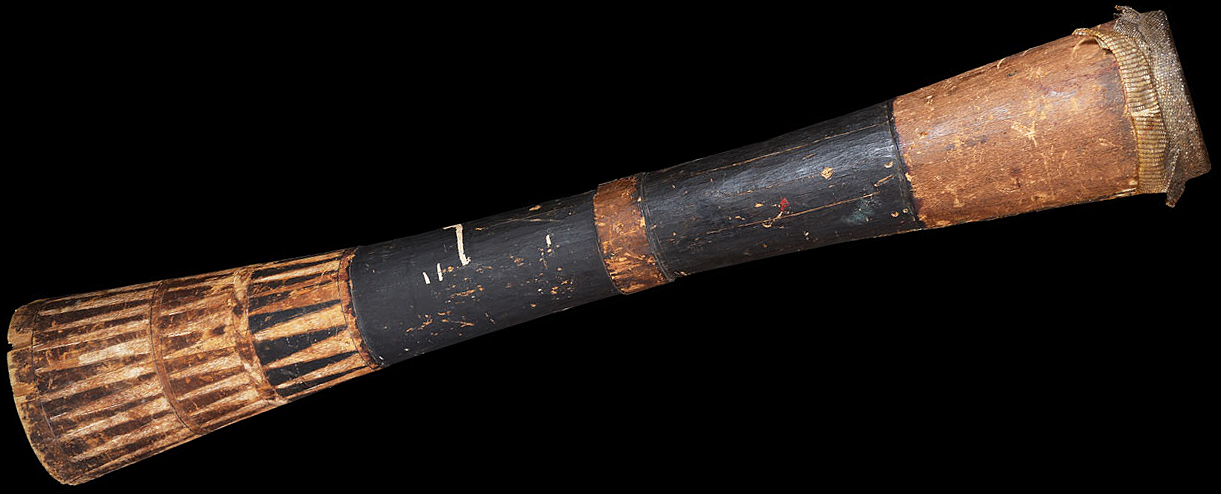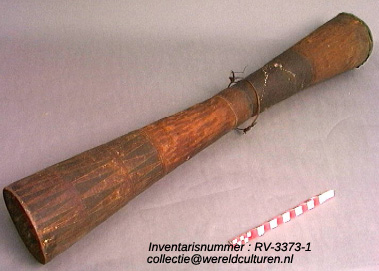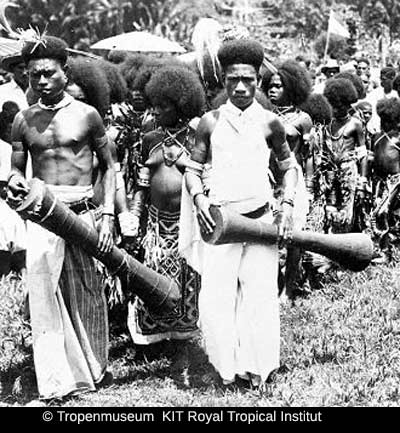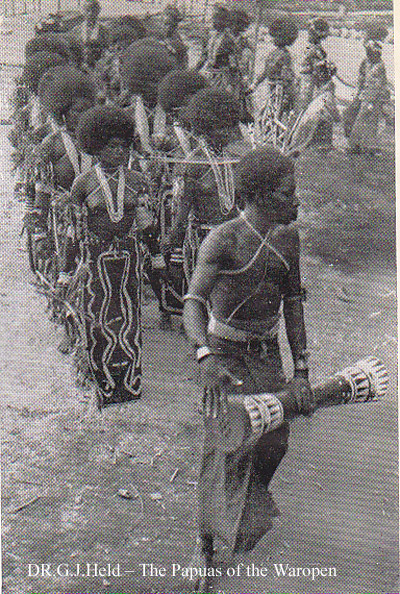DRUMS OF THE WORLD
New Guinea
Waropen Coast drum New Guinea
Geelvink bay - Waropen Coast or Kaimana region drum West Papua / Trommel West Papua
„The most important instrument is the drum (siwa), mainly imported from the Haarlem and Moor Islands, where the population possesses noticeable skill in wood-work.
At the dance the drums have to harmonise on two levels; for this purpose the drum-skins have to be constantly adjusted over a low fire,whilst small pieces of resin have to be stuck on them.
Evidently, the Waropen are rather demanding as regards the sound of the drum, the degree of the tension of the skin and the manner of beating.
To many drums they give a name of their own and even at a distance they recognise them by their sound."
Excerpt from: DR.G.J.Held – The Papuas of the Waropen, p.355. The Hague Martinus Nijhoff 1957
"The skin of the iguana, moiwa, which abounds here, is used for the drumheads. The skin is scraped clean while it is still fresh, stretched over a frame made of laths and dried in the sun. When a man wants to renew the skin on his drum, he first smears the rim with the sticky parings of the fruit of the mangrove. The skin is then made pliable by wetting it, pulled taut over the rim and bound tightly with a piece of cane. After that, the skin is thoroughly dried in the sun to fix it firmly to the drumhead and the strip of cane is then removed." Excerpt from the book: Kunst, Jaap - Music in New Guinea - Three Studies - p.106-107 - Brill 1967
"Muziek heeft vaak te maken met het contact tussen de mens en de bovennatuurlijke wereld. Het geluid van bepaalde instrumenten, zoals van deze trom, kan ervaren worden als de stemmen van de voorouders. Dergelijke instrumenten worden dan ook bij belangrijke ceremoniële gelegenheden bespeeld. Vaak wordt er ook bij gedanst. De bevolking van het Geelvinkbaaigebied houdt veel van feestvieren, of het nu ter ere van een eerstgeborene is of ter gelegenheid van een geslaagde haaien- of schildpaddenvangst. De feestelijkheden kunnen dagen en vooral nachten achtereen duren. In sommige streken maken mannen en vrouwen samen rondedansen, in andere, met name de oostelijker gebieden, danst men afzonderlijk. Als het kan wordt op het strand gedanst."
copyright: HI en DS, 1999 collectie@wereldculturen.nl
link: http://collectie.wereldculturen.nl/#/query/3007d953-d00b-4e4d-a6a3-6f82e0749645
Bibliography:
de Clercq, F.S.A. (1893) : Ethnographische Beschrijving van de West- en Noordkust van Nederlandsch Nieuw-Guinea. Leiden.
Greub, Suzanne (1992) : Art of Northwest New Guinea - From Geelvink Bay, Humboldt Bay and Lake Sentani.
Held, DR.G.J. (1957) : The Papuas of the Waropen. The Hague Martinus Nijhoff.
Kunst, Jaap (1967) : Music in New Guinea - Three Studies. Brill.
„The most important instrument is the drum (siwa), mainly imported from the Haarlem and Moor Islands, where the population possesses noticeable skill in wood-work.
At the dance the drums have to harmonise on two levels; for this purpose the drum-skins have to be constantly adjusted over a low fire,whilst small pieces of resin have to be stuck on them.
Evidently, the Waropen are rather demanding as regards the sound of the drum, the degree of the tension of the skin and the manner of beating.
To many drums they give a name of their own and even at a distance they recognise them by their sound."
Excerpt from: DR.G.J.Held – The Papuas of the Waropen, p.355. The Hague Martinus Nijhoff 1957
"The skin of the iguana, moiwa, which abounds here, is used for the drumheads. The skin is scraped clean while it is still fresh, stretched over a frame made of laths and dried in the sun. When a man wants to renew the skin on his drum, he first smears the rim with the sticky parings of the fruit of the mangrove. The skin is then made pliable by wetting it, pulled taut over the rim and bound tightly with a piece of cane. After that, the skin is thoroughly dried in the sun to fix it firmly to the drumhead and the strip of cane is then removed." Excerpt from the book: Kunst, Jaap - Music in New Guinea - Three Studies - p.106-107 - Brill 1967
"Muziek heeft vaak te maken met het contact tussen de mens en de bovennatuurlijke wereld. Het geluid van bepaalde instrumenten, zoals van deze trom, kan ervaren worden als de stemmen van de voorouders. Dergelijke instrumenten worden dan ook bij belangrijke ceremoniële gelegenheden bespeeld. Vaak wordt er ook bij gedanst. De bevolking van het Geelvinkbaaigebied houdt veel van feestvieren, of het nu ter ere van een eerstgeborene is of ter gelegenheid van een geslaagde haaien- of schildpaddenvangst. De feestelijkheden kunnen dagen en vooral nachten achtereen duren. In sommige streken maken mannen en vrouwen samen rondedansen, in andere, met name de oostelijker gebieden, danst men afzonderlijk. Als het kan wordt op het strand gedanst."
copyright: HI en DS, 1999 collectie@wereldculturen.nl
link: http://collectie.wereldculturen.nl/#/query/3007d953-d00b-4e4d-a6a3-6f82e0749645
Bibliography:
de Clercq, F.S.A. (1893) : Ethnographische Beschrijving van de West- en Noordkust van Nederlandsch Nieuw-Guinea. Leiden.
Greub, Suzanne (1992) : Art of Northwest New Guinea - From Geelvink Bay, Humboldt Bay and Lake Sentani.
Held, DR.G.J. (1957) : The Papuas of the Waropen. The Hague Martinus Nijhoff.
Kunst, Jaap (1967) : Music in New Guinea - Three Studies. Brill.




